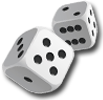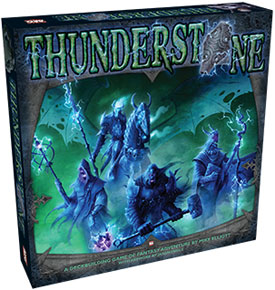



play board games
Board game reviews, strategy tips & session reports
Thunderstone Review
 Stats:
Stats:
No. of players: 1-5
Amount of time to play: 60-90 min
Age requirements: 12+
Set-up time: 10 min
Thunderstone Rules Description:
Thunderstone is a deck-building game in which you must enter the dungeon to attack monsters and recover the sacred Thunderstone. You gather your adventurers and equip them in the village. Can you be to first the find the Thunderstone and have the most victory points?
You set up Thunderstone by selecting four random heroes and eight random village cards. Every game also uses the four basic cards (Dagger, Iron Rations, Militia and Torch). These 16 cards make up everything your can purchase with a village action. You also select three random monster types and shuffle them together. This is your Dungeon Deck. Count out ten cards and shuffle in the Thunderstone card. These ten cards go at the bottom of the Dungeon Deck. Flip over the top three cards to reveal the monsters available to attack at the start of the game.
To begin you get a hand consisting of two Daggers, two Iron Rations, six Militia and two Torches. After shuffling, you draw six cards to form your starting hand. On your turn you have three actions you may take; a village action, a dungeon action or a rest action.
If you take a village action you may buy any one Village card or Hero. To figure out how much money you have, total the number of gold pieces you have on the cards currently in your hand. You may also level up heroes if you have enough Experience Point cards. All cards gained go in your discard pile and certain cards may give you extra cards or an extra buy.
Taking a dungeon action means you will attack one of the three monsters that have crept up from the dungeon. In order to defeat the monster you must have an attack value equal to or greater than its hit points. Each of your heroes has attack value and weapons or spell effects can add to this value.
The other think to consider when attacking is the order of the monsters. There are three ranks. The monster furthest to the right is in rank 1, the monster in the middle is in rank 2, and the monster closest to the Dungeon Deck is in rank 3. Hopefully you have a light source. Each light source gives you a certain amount of light. (Ex: a torch gives you one point of light) The amount of light you need increases with the Rank of the monster. For each light point you have you remove one rank from the darkness. And for each point of darkness that remains you take 2 off your attack value. So if you have one torch and are attacking the monster in the first rank you subtract nothing from your attack value. Attacking the middle monster in this case would take 2 off your attack value and attacking the monster in the third rank would take 4 off your attack. So the formula for this is (rank – light) X 2. If this is a negative value you subtract it from your attack value. I know that seems tough to calculate but after playing the game a bit it is not hard to figure out the light penalty.
Weapons can also add to your attack value, but your hero must be able to use the weapon you have for him. Each weapon has a weight and each hero has a strength value. If the hero’s strength is equal to or greater than the weapon’s weight, your hero can use it. Food and other cards can increase a hero’s strength value, but each hero may only wield one weapon.
Monsters will sometimes have battle effects. From immunities to non-magical attacks, giving you disease cards or killing a hero these effects vary based on the strength of the monster. The more powerful monsters have breach effects. These effects happen once the monster reaches rank 1 in the dungeon and affect all players.
If you defeat the monster it goes in your discard pile and you take Experience Point cards equal to its experience value. If you cannot defeat the monster it simply goes to the bottom of the deck and you discard your hand. Monsters are eventually drawn into your hand and tend to be worth some gold. They might even help you in battle and are worth victory points.
A rest action allows you to destroy one card from your hand. This can help you thin your deck or remove disease cards.
The game ends once the Thunderstone card reaches rank 1 of the dungeon. If you defeat the monster that was in rank 1 and that moves the Thunderstone into rank 1 you get the Thunderstone. If you do not win the last battle no one claims the Thunderstone card, but the game still ends. All players add up their victory points and the one with the most wins.
The solo rules are a lot of fun and it is nice to be able to play the game by your self. The rules are he same but the monsters advance a rank every round unless you attack one of them. If you attack them they will not advance the next round. This means you are taking a dungeon action pretty much every other round. If a monster makes past rank one without being defeated it reaches the village. Monster that reach the village go in a separate pile. At the end of the game you total that pile if it is greater than your total victory points you lose.
A Quick Review of Thunderstone:
Thunderstone has a great theme and it really comes through in the game. It feels like you are gathering your party for a dungeon crawl as you build your deck. There is definitely some luck in this game but there is strategy too. I know this game gets compared to Dominion a lot but it really is a different experience. The art in this game is beautiful as well.
A couple things to be aware of…First, having tough monsters at the beginning of the game can slow it down a bit. Second, like I said above this is not Dominion there is a bit more luck in Thunderstone. This may change if you own the expansions. I wish there was a bit more interactivity too.
I highly recommend this game to anyone who enjoys fantasy- themed games or rpgs. Also the fact you can play solo adds to its value.
Score and synopsis: (Click here for an explanation of these review categories.)
Strategy 3 out of 6
Luck 4 out of 6
Player Interaction 2 out of 6
Replay Value 5 out of 6
Complexity 4 out of 6
Fun 5 out of 6
Overall 4 out of 6

One other thing I meant to mention. The whole math formula to figure out the light and how it effects your attack value seems complicated. And believe me I am no math wiz, but halfway through the first game we had it down.